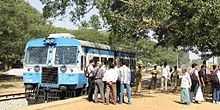Railbus




_01.jpg)


- Not to be confused with a Train-replacement bus service
A railbus is a very lightweight type passenger rail vehicle (typically non-articulated or rigid frame) that shares many aspects of their construction with a bus, usually having a bus, or modified bus body, and having four wheels on a fixed base, instead of on bogies. These railbuses, a design developed in the 1930s, have evolved into larger dimensions, performance and characteristics similar in appearance to a light railcar, and today the terms railcar and railbus are often used interchangeably.
Railbuses designed for use specifically on little-used railway lines were commonly employed in countries such as Germany, Italy, France, United Kingdom and Sweden.[1] Today railbuses are being replaced by modern light DMU railcar designs.
British Rail railbuses
British Rail produced a variety of railbuses as a means both of building new rolling stock cheaply, and to provide services on lightly used lines economically.
A variety of railbus known as Pacers, which were constructed in the 1980s, are still in common use today, although they are being gradually replaced.
German railbuses
In Germany, the Schienenbus was developed in the 1930s to fulfill the need for an inexpensive rail vehicle built to standard specifications on Germany’s Reichsbahn (the predecessor to DB) to meet the demand for cost-effective services on light railways or Kleinbahnen, and the Wismar railbus were pioneers in those days. These were followed after the Second World War by the eventually ubiquitous Uerdingen railbuses which generally ran in pairs and were a predecessor of the modern diesel multiple units.
A number of serious accidents in Germany in the late 1970s involving Schienenbus resulted in the development and specification of larger, more robustly designed diesel railcars. Although these cars were more similar in size to the U.S. produced diesel railcars, they would not have complied with current FRA requirements, and, like their North American cousin rail diesel cars, are largely railroad-derivative designs. The DB Class 628 series exemplifies the contemporary German diesel railcar. This type of car replaced the Schienenbus and locomotive-hauled train consists where possible on branch-line and main-line assignments during the 1980s and 1990s. The Schienenbus has virtually disappeared from regular revenue service, but its rail diesel car successors are prevalent. A new-generation DMUs third in succession after the Schienenbus, are now being ordered by the hundreds by its diversity and the variety of modular design combinations.[2]
Australian railbuses
In 1937 the NSW Department of Railways added six four-wheel streamlined rail buses to serve on small branch lines in Cowra and Harden that did not have enough passengers to justify a rail motor.[3] Powered by a Ford V8 engine, they were given the designation FP1 to FP6. When the railbus service wasn't popular, several of the buses became mobile pay cars used to pay railway employees at stations and working on tracks.
In December 1941 one of these railbuses (FP 5) was destroyed when dynamite was placed on railway tracks near Yanderra. The three man crew of the railbus were killed in the explosion. Though £2000 of loose cash was taken, the safe in the railcar could not be opened by the robbers. No one was prosecuted for the offence.[4]
The first railbus, FP1 has been restored where it is on display at New South Wales Rail Transport Museum in Thirlmere, New South Wales.
Railbus services around the world

Australia
In Queensland, Australia, "Railbus service" refers to the (road) bus service running parallel to portions of some railway lines, substituting for commuter train.
India
Indian Railways operate many Railbuses and amongst it, one runs from Kolar [KOZ] to Bangarpet [BWT].The Bangarpet-Kolar broad gauge railbus was manufactured by Bharat Earth Movers Limited (BEML) in 1997. It is a self-powered four-wheeled locomotive with driving cabs at both ends and controls for bi-directional operation. The 72-seater railbus is a boon for about 65 office workers who commute from Bangalore to Kolar by train every day. A loco pilot who is accompanied by an assistant loco pilot operates the railbus, which is like a chartered service for the regulars. A single track connects the The quaint Kolar station.Bangarpet and Kolar stations and the “one train only token system” is used to control rail traffic on this line. A baton with the two station names etched on it authorises a single train to pass through. The arrival and departure of the railbus from Bangarpet are linked to the timings of the connecting trains to and from Bangalore.[5]
Indonesia
On August 5, 2012 the first Batara Kresna Railbus service in Indonesia is launched to accommodate a part of commuter Prameks Train passengers from Solo to Yogyakarta City v.v through Sukoharjo.[6]
Sri Lanka
In areas without significant demand for regular commuter trains, such as in the Eastern province, railbus connects towns and cities. Railbus between Batticaloa and Trincomalee allows passengers to travel between the two cities with fewer delays.[7]
See also
References
- ↑ Hilding Carlsson and his Railcar Company - Retrieved on 2010-04-20
- ↑ www.onlinepubs.trb.org Transit Cooperative Research Program - Research Results Digest- September 2001—Number 43, page 27 - Retrieved on 2010-05-01
- ↑ http://www.nswrailheritage.com.au/orhprojects/cashontrack/firstfleet.htm
- ↑ http://coalstonewcastle.railpage.org.au/content/downloads/stock/files/nsw_paybus_readme.txt
- ↑ Satish, Shalini. "Railcar’s last stop". Heritage. The Deccan Herald. Retrieved 5 January 2013.
- ↑ "Railbus Batara Kresna Akhirnya Meluncur". August 5, 2012.
- ↑ "The Island". Eastern Province railbus project commences. 2009-07-30.
External links
| Wikimedia Commons has media related to Railbuses. |